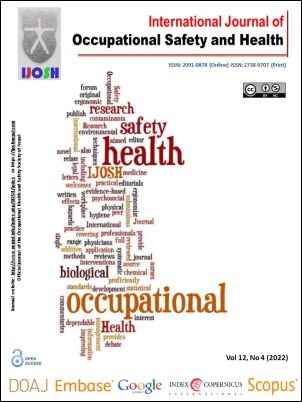Scientific Model Development for Machinery Safety using Machine Reliability, Integrity and Availability
DOI:
https://doi.org/10.3126/ijosh.v12i4.42147Keywords:
work, occupational health, equipment safety, safety management, health and safetyAbstract
Introduction: Machines are equipment that increases productivity and efficiency in a workplace. Machine Reliability, Integrity, and Availability are the most critical factors to ensure machinery safety in a workplace.
Methods: Throughout this study, a series of reviews of previous literature are described in relation to the elements of reliability, integrity and availability. This study examines the methods used to investigate levels of each element as well as the results of performing the analysis. Each review is chosen from the aspect of the safety feature that can be interpreted from the research study. A scientific model that utilizes an improved Bottom-up Approach is proposed to further improve the worker's safety and enhance the productivity of an industry.
Results: Research shows that the chosen reviews have positive and negative change towards the level of machinery safety and a more substantial approach is needed to further strengthen the issue. The proposed model combines the effort of employee and various management organization as a team. The model is validated using Bias- Variance Trade off method that analyses the proposed model in a 27MW power plant with a selection of employee and management.
Conclusion: Model validation proves that the proposed model is an effective method to increase the machinery reliability, integrity and availability in a workplace. The scientific methodology provided will help management as a team to avert mechanical accidents from occurring at an initial stage.
Downloads
Downloads
Published
How to Cite
Issue
Section
License
Copyright (c) 2022 Kartikeyan Patma Nesan, Azizul Buang, Sivabalan Kaniapan, Dzulkarnain Zaini

This work is licensed under a Creative Commons Attribution-NonCommercial 4.0 International License.
This license enables reusers to distribute, remix, adapt, and build upon the material in any medium or format for noncommercial purposes only, and only so long as attribution is given to the creator.





